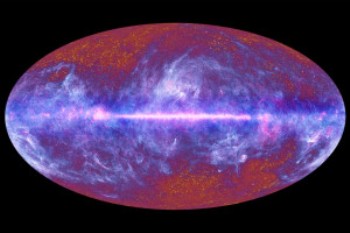Mar 25 2013
Europe’s Planck space telescope, which University of Manchester scientists at the Jodrell Bank Observatory helped build, has compiled the most detailed map of the post-Big Bang Universe ever recorded and thrown up anomalies that current physics cannot yet explain.
 A false-colour image of the whole sky as seen by Planck
A false-colour image of the whole sky as seen by Planck
But the data – released today (Thursday) by the European Space Agency – also provides the best evidence yet to support the standard model of cosmology, dates the Universe at 13.82 billion years and refines our knowledge of the Universe’s composition and evolution.
The Planck satellite telescope, a flagship mission for the UK Space Agency, has produced the most accurate values yet for the ingredients of the Universe, with normal matter – the things we see and feel around us – making up just 4.9% of the Universe’s density (mass and energy) and dark matter contributing 26.8%, nearly a fifth more than previously estimated.
Professor Richard Davis, who led the University of Manchester Planck team, said: “The information extracted from Planck’s new map provides excellent confirmation of the standard model of cosmology with unprecedented accuracy and sets a new benchmark for our knowledge of the ingredients of the Universe.
“But because the precision of Planck’s map is so high, it has also revealed some unexplained anomalies in the data that require further study. Among these interesting findings are fluctuations in the cosmic microwave background over large scales that do not match what the standard model of physics predicts, including an asymmetry in the average temperatures on opposite hemispheres of the skies.”
The Planck telescope’s image is based on the initial 15 months of data and is the mission’s first all-sky picture of the oldest light in the Universe, imprinted when the Universe was just 380,000 years old. The cosmic microwave background (CMB) the telescope has measured shows tiny temperature fluctuations that correspond to regions of slightly different densities at very early times after the Big Bang; these fluctuations represent the seeds of all future structure – the stars and galaxies – we see today.
One way to explain the anomalies is to propose that the Universe is not, in fact, the same in all directions on a larger scale than we have so far observed. In this scenario, the light rays from the CMB may have taken a more complicated route through the cosmos than previously understood, resulting in some of the unusual patterns observed by Planck.
Professor Richard Battye, from the Jodrell Bank Centre of Astrophysics at The University of Manchester, said: "Planck has provided us with a huge amount of information about the nature of the very early Universe and the fundamental processes taking place there. The data are broadly consistent with the standard picture that has emerged over the last 20 years, but there are also a number of tantalising hints that there is something missing in our understanding. It will be fun trying to figure out what is going on."
Dr Chris Castelli, Acting Director of Science, Technology and Exploration at the UK Space Agency, said: “With its ability to make such detailed and accurate observations, Planck is helping us to place the vital pieces of the jigsaw that could give us a full picture of the evolution of the Universe, rewriting the textbooks along the way.”
George Efstathiou, University of Cambridge, added: “The CMB temperature fluctuations detected by Planck confirm once more that the relatively simple picture provided by the simple model is an amazingly good description of the Universe.”